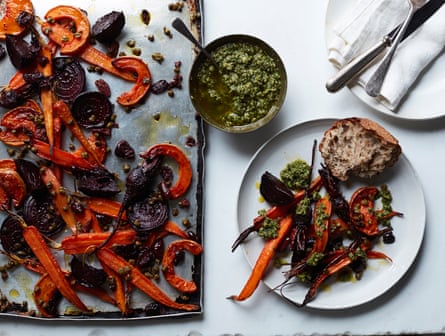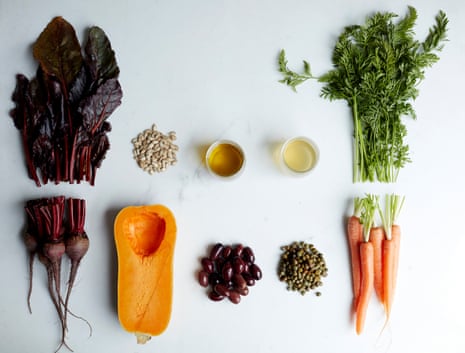We talk a lot about waste these days. Rigid sell-by dates and a squeamish attitude to imperfection encourage us to throw away perfectly good food: tops are cut off turnips, beetroot and carrots before we have even had a chance to think of using them; ingredients prepared in advance in restaurants are destined for the bin on a quiet night; butternut squash cores and seeds are thrown out when making spiralised vegetable noodles; and imperfect melon trimmings are abandoned to make our little pots of pre-chopped fruit more presentable ... And that’s without even a mention of the fuel and water that has been used to produce and transport it all. A third of the food we produce worldwide goes to waste, enough to feed 17 million people. There is so much work to be done and I am sure I don’t even know the half of it.
The Guardian’s product and service reviews are independent and are in no way influenced by any advertiser or commercial initiative. We will earn a commission from the retailer if you buy something through an affiliate link. Learn more.
Recently, this talk of waste has spread to our top dining rooms. Only this week, one of my favourite British cooks, Skye Gyngell, launched her “scratch” menu at her restaurant, Spring (see p12). It’s a more affordable selection made with ingredients that are often overlooked.
Another chef whose cooking I have long admired is Dan Barber, from Blue Hill in New York, who brings his food waste celebration wastED to a pop-up at Selfridges this month.
So, with this in mind, I have been cooking using the whole ingredient, trying not to throw any of the precious food I have bought into the bin (I hope you will excuse me a couple of onion and garlic skins). A humble pot of buttery beans made with the liquid they were cooked or canned in, whole vegetables, tops, peel, stalks and all. As well as a tray of simply roasted carrots and beets, with olives and capers, and a punchy pesto made with the brine, oil and root tops: all the things that would otherwise be wasted.
Roast roots with ‘waste’ pesto
Serves 4
1 bunch of carrots with tops
1 bunch of beetroots with tops
1 small butternut squash
100g whole black olives in oil
2 tbsp baby capers in brine
1 unwaxed lemon
1 whole garlic bulb
A chunk of hard, white cheese (whatever you have in your fridge)
Extra virgin olive oil

1 Preheat the oven to 200C/400F/gas mark 6. Separate the tops from the carrots and beetroots, wash and put to one side for later. You need to wash the vegetables really well – the carrots and beetroots will need a good scrub, as you’re not going to peel them. Slice each beetroot into quarters, or halves if they are small, and the carrots in half lengthways, or quarters if they are really big.
2 Cut the butternut squash in half lengthways and use a spoon to scoop out the seeds (set aside to use later). Slice the squash into 1cm-thick, cresent‑shaped wedges.
3 Tip all the vegetables into a large baking tray and drizzle with a good glug of the oil from the olive jar. Drizzle about 2 tbsp of the caper brine over the vegetables – this will be your salt – then add the olives and capers and give everything a good mix.
4 Grate over the zest of the lemon, then cut it in half and add to the tray along with the whole bulb of garlic. Bake for 30-40 minutes, or until the vegetables are cooked through and golden edged.
5 Meanwhile, wash the squash seeds under cold running water to get rid of any fibrous bits. Coat with a little more oil from the olives, then roast in the oven for 10 minutes, or until you can hear them start to pop and they look a shade darker.
6 Once the vegetables are cooked, remove the tray from the oven, carefully spoon out the lemon and garlic, and put the vegetables back in the oven to keep warm.
7 To make the pesto, squeeze the roasted garlic out of its papery skin into the bowl of a food processor. Add the roasted pumpkin seeds, whole roasted lemon and grated cheese, if you’re using it, then blitz to a coarse paste. Add the carrot and beetroot tops and some olive oil (use up the oil from the olive jar, then add a little more if you need, or just add a splash of water). Pulse until you have a chunky pesto. Season with a little caper brine.
8 Serve the roast vegetables with the pesto alongside for spooning. Freeze leftover pesto in freezer bag, or keep it in a jar in the fridge, covered with a thin layer of olive oil, where it will keep for up to a week.
Use-it-all Boston beans
If you want to cook your own beans from scratch, soak them overnight, then add to a saucepan and fill with cold water to a depth of about 3cm above the top of the beans, bring to a rapid boil for 5 minutes, then turn down to a very gentle simmer until cooked through and tender.

Serves 4
400g dried haricot beans, cooked, cooking water reserved; or 3 x 400g tins of haricot beans, liquid reserved
1 heaped tsp English mustard powder or 1 tbsp jarred mustard
1 tbsp molasses
2 tbsp Worcestershire sauce (I use a vegetarian one)
1 large onion, peeled and halved
2 tomatoes, stalks and all
2 carrots, scrubbed
1 large leek, washed and cut into a few big chunks (use both the green and white parts)
1 whole chipotle chilli
1 bay leaf
Flaky salt
1 Put a large cast-iron pot or deep saucepan on a low heat, then add the beans and their liquid to the pot, along with the mustard powder, molasses and Worcestershire sauce. Give it a good stir.
2 Nestle the onion, tomatoes, carrots, leek, chilli and bay leaf in among the beans. Add up to another 200ml of cold water, so that everything is just covered by the liquid. How much water you add will depend on the exact amount of liquid that you have in the tins or leftover from cooking: you want it to just barely cover the beans.
3 Put a lid on the pot. Bring to a gentle simmer, then turn the heat down and cook on a very low heat for an hour without stirring (stirring will break up the beans) until the sauce is thick and sticky. You may want to remove the lid for the last 30 minutes if it looks like there is too much liquid.
4 Carefully remove the onion, tomato, carrots, leek, chilli and bay leaf. Discard the bay leaf, then set the rest aside for a few minutes to cool slightly before spooning into a food processor and blitzing until smooth. Once smooth, stir it back into the beans.
5 Next, add a good amount of salt to the beans, stir well and taste. Balance with a little Worcestershire sauce, molasses, mustard or salt, if needed.
6 Serve your beans simply on toast or topped with a poached egg.
- Anna Jones is a chef, writer and author of A Modern Way to Eat and A Modern Way to Cook (Fourth Estate); annajones.co.uk; @we_are_food

Comments (…)
Sign in or create your Guardian account to join the discussion